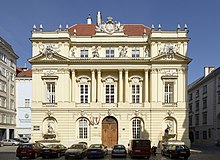Austrian Academy of Sciences
| Österreichische Akademie der Wissenschaften | |
 | |
 | |
| Agency overview | |
|---|---|
| Formed | 1847 |
| Type | National academy |
| Jurisdiction | Austria |
| Headquarters | Vienna, Austria |
| Agency executives |
|
| Website | www.oeaw.ac.at |
The Austrian Academy of Sciences (German: Österreichische Akademie der Wissenschaften, ÖAW) is a legal entity under the special protection of the Republic of Austria. According to the statutes of the Academy its mission is to promote the sciences and humanities in every respect and in every field, particularly in fundamental research.
History[]
In 1713, Gottfried Wilhelm Leibniz suggested to establish an Academy, inspired by the Royal Society and the French Academy of Sciences. The "Kaiserliche Akademie der Wissenschaften in Wien" was finally established by Imperial Patent on 14 May 1847. The academy soon began extensive research. In the humanities the academy started with researching and publishing important historical sources of Austria. Research in natural science also covered a wide variety of topics.
The 1921 federal law guaranteed the legal basis of the academy in the newly founded First Austrian Republic. From the mid-1960s onwards it became the country's leading institution in the field of non-university basic research.[citation needed]
The academy is also a learned society, and its past members have included Theodor Billroth, Ludwig Boltzmann, Christian Doppler, Anton Eiselsberg, Otto Hittmair, Paul Kretschmer, Hans Horst Meyer, Albert Anton von Muchar, Julius von Schlosser, Roland Scholl, Eduard Suess and the Nobel Prize winners Julius Wagner-Jauregg, Victor Francis Hess, Erwin Schrödinger and Konrad Lorenz.[1]
Research facilities[]
The academy operates 25 research institutes. In 2012, a reorganization prompted the outsourcing of various institutes to universities as well as mergers. The academy's institutes are split into two major divisions, one for mathematics and natural sciences (mathematisch-naturwissenschaftliche Klasse) and one for humanities and social sciences (philosophisch-historische Klasse).
In the field of humanities, there are the , which is well known for the analysis of excavation results in Carnuntum and Ephesos, the , focusing on montology, the , and the Vienna Institute of Demography, among others.
Facilities that focus on natural sciences include the Institute of Molecular Biotechnology (which is operated in cooperation with Boehringer Ingelheim), the Gregor Mendel Institute, the , the , the , the Institute for Quantum Optics and Quantum Information, the Acoustics Research Institute and the Space Research Institute.
Gallery of Research[]
During his term as president of the academy (1991–2003), Werner Welzig initiated the establishment of the Galerie der Forschung (English: Gallery of Research).[2] In 2005 the Gallery organised its pilot event "Mapping controversies: the case of the genetically modified food",[3] which was staged in the Alte Aula in Vienna.
Publications[]
The academy publishes Medieval Worlds: Comparative & Interdisciplinary Studies, a biannual peer-reviewed open access academic journal covering Medieval studies. Its main scope is the time period from roughly 400 to 1500 CE, with a focus on Europe, Asia, and North Africa. The founding editors-in-chief are Walter Pohl and Andre Gingrich. The journal was established in 2015 with initial funding of the Austrian Science Fund.[4][5] Scholarly reviewers have found the journal noteworthy for its programmatic efforts to change the parameters of Medieval Studies, making the field less Eurocentric and attempting to integrate it into comparative history, world history, and interdisciplinary history-writing.[6] They noted that it was promoting a new trend for 'wide-ranging comparison on a Eurasian scale'[7] and numbered it among 'initiatives which speak either directly or indirectly to the notion of a global history for the millennium before 1500'.[8] The journal's push for a new interdisciplinarity was particularly noted in a review of its fourth issue, on the historiographical consequences of archaeogenetic research.[9]
Other publications are the Corpus Scriptorum Ecclesiasticorum Latinorum and eco.mont – Journal on Protected Mountain Areas Research and Management. Also Memoranda of the Academy of Knowledge. Mathematical and natural science class (Denkschriften der Akademie der Wissenschaften), which was founded in 1850.[10]
References[]
- ^ Basic information from official website Archived October 2, 2007, at the Wayback Machine
- ^ "Press release of the Austrian Academy of Sciences" (PDF). Archived from the original (PDF) on 2011-05-31. Retrieved 2009-02-24.
- ^ "Announcement of the event on the website of the European Commission" (PDF). Archived from the original (PDF) on 2007-03-25. Retrieved 2009-02-24.
- ^ Reckling, Falk; Scherag, Eva. "1 Report Initial funding for high - quality open access journals in the humanities and social sciences" (PDF). Austrian Science Fund (FWF). Retrieved 9 January 2019.
- ^ Schousboe, Karen (24 August 2015). "Medieval Worlds". Medieval Histories. Medieval Histories. Retrieved 2019-01-09.
- ^ Stuart Airlie, Maud Anne Bracke and Rosemary Elliot, 'Editorial', Gender & History, 28 (2016), 275-82 (p. 281, fn. 19) doi:10.1111/1468-0424.12205.
- ^ Pohl, Walter (2016). "Introduction: Meanings of Community in Medieval Eurasia". In Eirik Hovden; Christina Lutter; Walter Pohl (eds.). Meanings of Community across Medieval Eurasia: Comparative Approaches. Brill. pp. 1–24. JSTOR 10.1163/j.ctt1w76w6c.5.
- ^ Catherine Holmes and Naomi Standen, 'Introduction: Towards a Global Middle Ages', Past & Present, 238, Issue suppl. 13 (1 November 2018), 1–44, doi:10.1093/pastj/gty030.
- ^ Alfons Labisch, 'Molecular Historiography–neue Gegenstände und neue Methoden einer neuen Geschichtsschreibung?', NTM: Zeitschrift Für Geschichte Der Wissenschaften, Technik Und Medizin, 26(3), 351–366; doi:10.1007/s00048-018-0198-7.
- ^ "Zobodat - Literatur Serien". www.zobodat.at. Retrieved 9 August 2020.
External links[]
| Wikimedia Commons has media related to Austrian Academy of Sciences. |
Coordinates: 48°12′31″N 16°22′39″E / 48.20872°N 16.37739°E
- Austrian Academy of Sciences
- Organisations based in Vienna
- 1921 establishments in Austria
- Scientific organizations established in 1921
- Members of the International Council for Science
- History journals
- Publications established in 2015
- English-language journals
- Online-only journals
- Biannual journals
- Open access journals
- Members of the International Science Council

